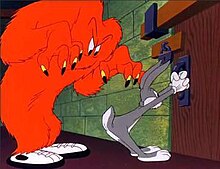Gossamer (Looney Tunes)
| Gossamer | |
|---|---|
| Looney Tunes character | |
 Gossamer and Bugs Bunny in Hair-Raising Hare | |
| First appearance | Hair-Raising Hare (1946) |
| Created by | Chuck Jones Michael Maltese |
| Designed by | Bob Givens |
| Voiced by | Mel Blanc (1946–1980) Frank Welker (1990) Maurice LaMarche (1995, 2002) Jim Cummings (1996–2006) Joe Alaskey (2000–2001) Kwesi Boakye (2011–2014) Eric Bauza (2018)[1] Fred Tatasciore (2020–present)[2] |
| In-universe information | |
| Species | Monster |
| Gender | Male |
Gossamer is an animated character in the Warner Bros. Looney Tunes and Merrie Melodies series of cartoons. He is a large, hairy, orange[3] monster. His body is perched on two giant tennis shoes, and his heart-shaped face is composed of only two oval eyes and a wide mouth, with two hulking arms ending in dirty, clawed fingers. The monster's main trait is his uncombed, orange hair. He originally was voiced by Mel Blanc and has been voiced by Frank Welker, Maurice LaMarche, Joe Alaskey, Jim Cummings, Kwesi Boakye, Eric Bauza and currently Fred Tatasciore.
The word gossamer means any sort of thin, fragile, transparent material. In particular, it can refer to a kind of delicate, sheer gauze or a light cobweb. The name is meant to be ironic because the character is large, menacing, and destructive.[4]
History[]
Animator Chuck Jones introduced the unnamed monster in the 1946 cartoon Hair-Raising Hare.[5] In it, Bugs Bunny is lured to the lair of a mad scientist (a caricature of actor Peter Lorre).[6][7] The monster serves as the scientist's henchman.
Part of this plot was repeated in the 1952 Jones cartoon Water, Water Every Hare[8] in which the monster's character is referred to as "Rudolph" or simply "Monster". In need of a live brain for his giant robot, the mad scientist (this time a caricature of Boris Karloff) releases Rudolph from his chamber on a mission to capture Bugs Bunny; the monster shows a sudden burst of joyousness and quickly sets out when the mad scientist promises the reward of "spider goulash" for capturing the rabbit.
The monster next appears in Duck Dodgers and the Return of the 24½th Century in 1980. This is the first cartoon where the character is called "Gossamer", and is so named by Marvin the Martian.[5] Jones gave the monster this name "because he's the opposite looking of gossamer. He's a big, hairy thing."[4]
In the 1995 short film, Carrotblanca, Gossamer is seated at a table.
Other appearances[]
Gossamer also has appeared in various recent Warner Bros. productions:
- Gossamer cameos in the 1996 film Space Jam.
- Gossamer appears as a playable character in the video games Looney Tunes: Back in Action, Looney Tunes: Acme Arsenal, Looney Tunes Dash and Looney Tunes: World of Mayhem.
- A toddler version of Gossamer appeared in the Baby Looney Tunes episode "Stop and Smell Up the Flowers". He frightens the other Baby Looney Tunes trying to get lemons from them. Gossamer is also a friend of Baby Pepé Le Pew.
- Gossamer appears in The Looney Tunes Show voiced by Kwesi Boakye. Gossamer here is the opposite of previous portrayals, being a timid and kind child. He has a bond with Daffy Duck, who serves as a sort of mentor and father figure to him despite Daffy’s rivalry with Gossamer’s mother Witch Lezah.
- In the most recent series, Looney Tunes Cartoons, he is back to his classic role as a monster who hunts Bugs Bunny down. He tries to catch Bugs Bunny in "Big League Beast", voiced by Fred Tatasciore.
- Gossamer appears in Space Jam: A New Legacy. He appears as a member of the Tune Squad during the basketball match against the Goon Squad. Gossamer's fur was briefly used to absorb Wet-Fire's water form.
References[]
- ^ "Gossamer". Behind The Voice Actors. Retrieved 26 December 2020.
- ^ "Looney Tunes Cartoons Characters Revealed in New HBO Max Images". Collider. 5 May 2020.
- ^ "Gossamer".
- ^ a b Korkis, Jim. "The Return of Duck Dodgers". Outré magazine. 1 (7). p. 86.
- ^ a b Beck, Jerry, ed. (2020). The 100 Greatest Looney Tunes Cartoons. Insight Editions. p. 85. ISBN 978-1-64722-137-9.
- ^ Greenberg, Harvey Roy (2004). "Heimlich Maneuvers: On A Certain Tendency of Horror and Speculative Cinema". In Shneider, Steven Jay (ed.). Horror Film and Psychoanalysis: Freud's Worst Nightmare. Cambridge University Press. p. 130. ISBN 9781139453684.
- ^ Youngkin, Stephen D. (2005). "Being Slapped and Liking It". The Lost One: A Life of Peter Lorre. University Press of Kentucky. p. 214. ISBN 9780813137001.
- ^ Beck, Jerry; Friedwald, Will (1989). Looney Tunes and Merrie Melodies: A Complete Illustrated Guide to the Warner Bros. Cartoons. Henry Holt and Co. pp. 234–235. ISBN 0-8050-0894-2.
External links[]
- All about Gossamer on Chuck Jones Official Website.
- Looney Tunes characters
- Film characters introduced in 1946
- Fictional monsters